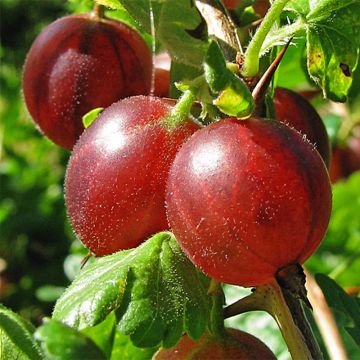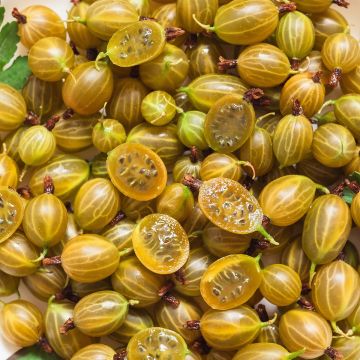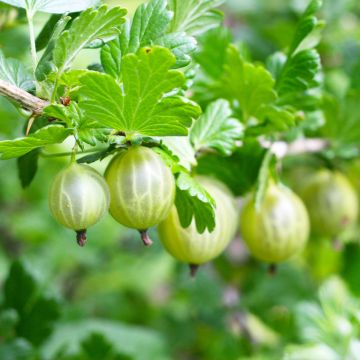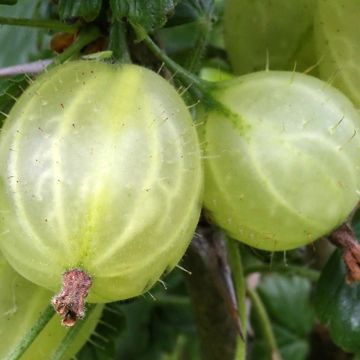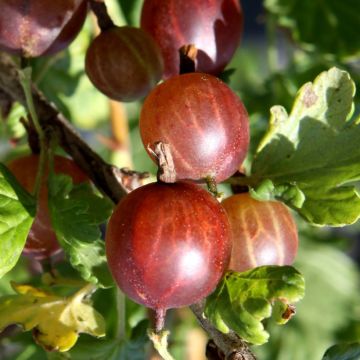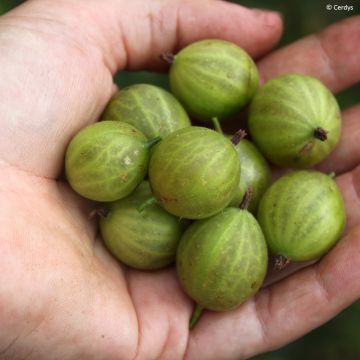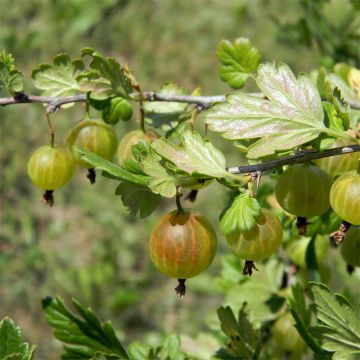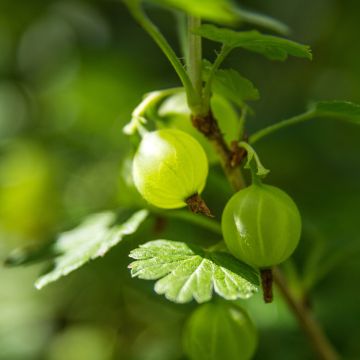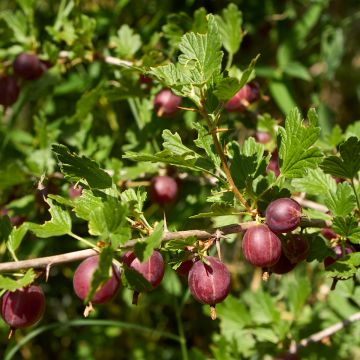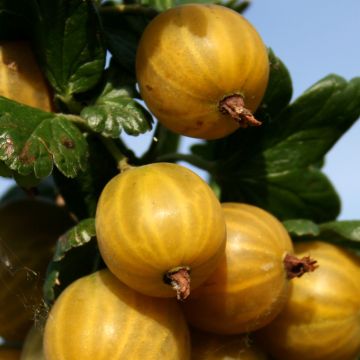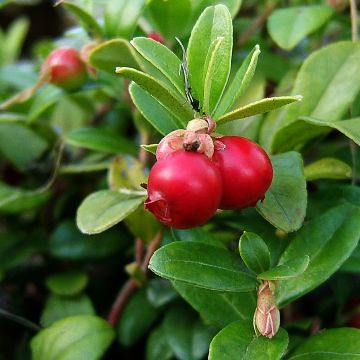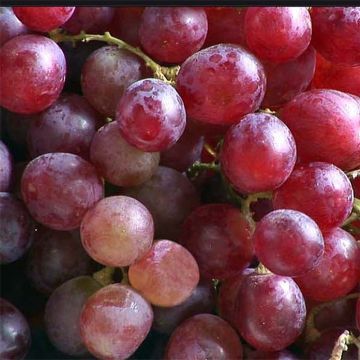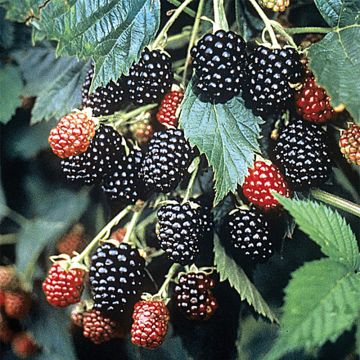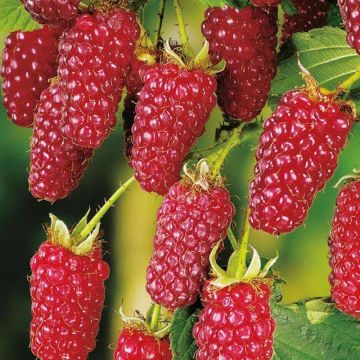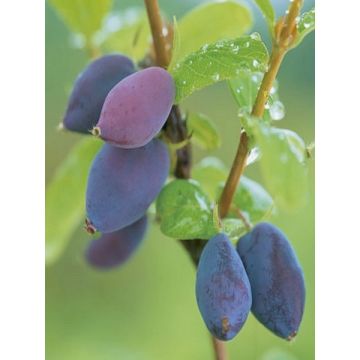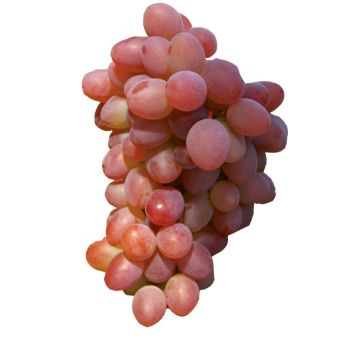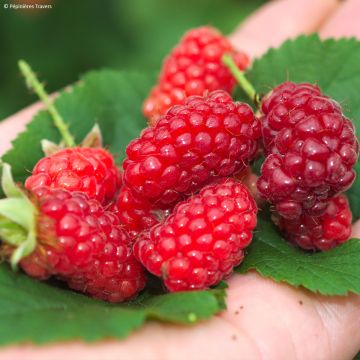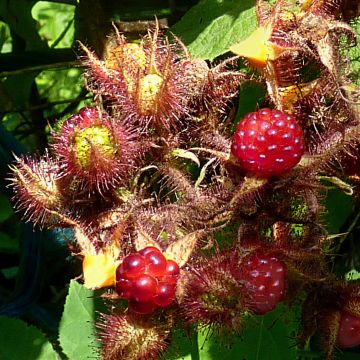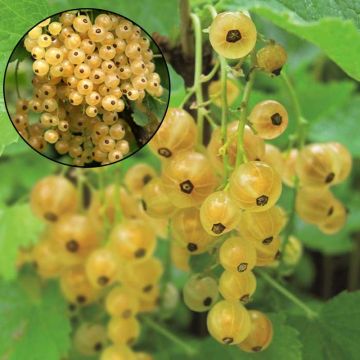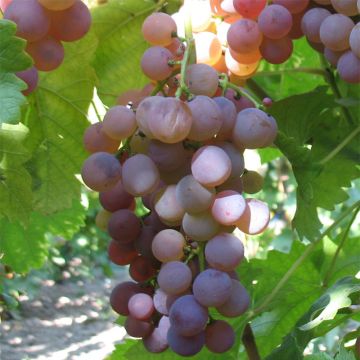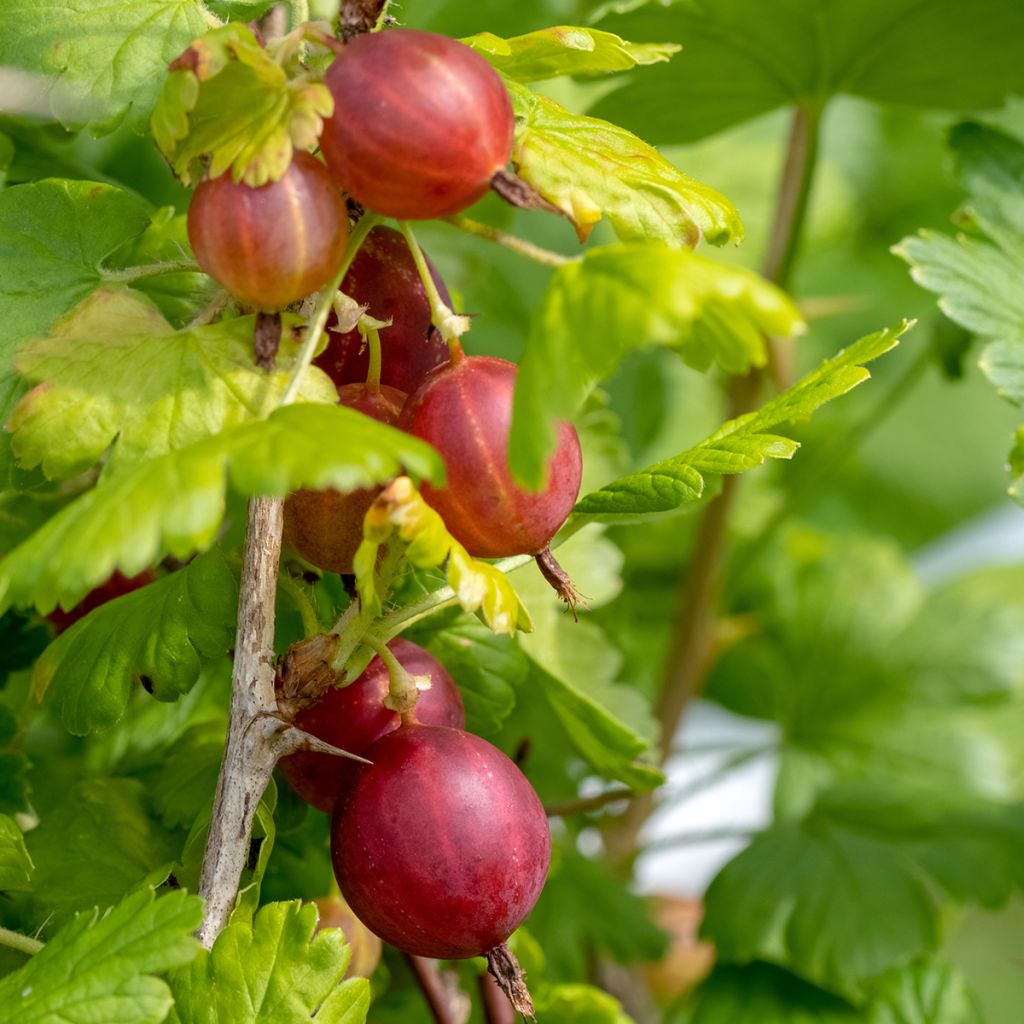

Ribes uva-crispa Easycrisp 'Lady Late'
Ribes uva-crispa Easycrisp 'Lady Late'
Ribes uva-crispa Easycrisp ® Lady Late ®
Gooseberry
This item cannot be shipped to the selected country
Delivery charge from €5.90
More information
Schedule delivery date,
and select date in basket
This plant carries a 6 months recovery warranty
More information
We guarantee the quality of our plants for a full growing cycle, and will replace at our expense any plant that fails to recover under normal climatic and planting conditions.
From €5.90 for pickup delivery and €6.90 for home delivery
Express home delivery from €8.90.
Description
The Easycrisp 'Lady Late' Gooseberry is a recent selection that stands out for its almost thornless branches as they age, its regular and high yield of hairless, juicy, sweet and fruity flavoured fruits, and its healthy growth as well as its good tolerance to powdery mildew. In summer, gooseberries are delicious and enhance salads, savoury dishes, or desserts. In April, its greenish-white flowers, somewhat insignificant, are a food source for bees and other beneficial insects. A sunny exposure and nutrient-rich soil are necessary for an excellent harvest. This bush is relatively undemanding and resistant to diseases. It can be grown in open ground or pots. Easy to maintain and generous, it brings pleasure and enchantment to the garden—plant from October to March for a harvest in July-August.
The Gooseberry, in Latin Ribes grossularia var. uva-crispa, also called Spiny Gooseberry or Curly Grape, belongs to the Grossulariaceae family, like the Red Currants (Ribes rubrum) and the Blackcurrants (Ribes nigrum). The name "Gooseberry" comes from the English, who have been using this gooseberry for a long time to make a sweet and sour sauce to accompany mackerel. Cultivated in northern Europe since the 16th century, the Gooseberry is a fertile hybrid resulting from cross-breeding two species native to Europe and North Africa, still spontaneous in mountain forests in Scotland, France, and the Caucasus.
The Ribes uva-crispa Easycrisp 'Lady Late' is a recent Swiss creation from the Easycrisp range. A range of gooseberry varieties selected for their high yields, large aromatic and juicy fruits, on almost thornless, vigorous and disease-resistant plants, especially powdery mildew. It forms a bushy, sparsely thorny shrub with a tufted habit of slightly stiff, branched and upright branches. This very hardy bush will reach a height of 1 m (3ft) with a spread of 80 cm (32in). The foliage is deciduous, composed of palmate, lobed, and aromatic leaves, medium green. This shrub resembles classic gooseberries but is mainly different in the fruits: larger and sweeter, they appear solitary along the branches, unlike cluster gooseberries. Flowering occurs in spring, in clusters of small greenish insignificant flowers intensely visited by bees. Fruiting occurs more on one and two-year-old branches. The harvest takes place from late July to mid-August. The bush then becomes covered with large smooth-skinned berries, round to oval, 1.4 cm (1in) in diameter, distributed along the branches. At maturity, the gooseberries turn bright red and are filled with translucent, juicy, fruity, sweet, and slightly acidic pulp containing tiny seeds.
Lady Late Gooseberry is self-fertile, so it does not need a companion to bear fruit, but the presence of another variety nearby will increase production. Harvesting is done as the fruits ripen. It is simplified due to the size of the berries. A gooseberry bush produces about 3 to 5 kg of fruits per plant, depending on the age and growing conditions of the plant. The fruits contain vitamin C, antioxidants, minerals, trace elements, potassium, calcium, and phosphorus.
Moreover, their low sugar content classifies them among the least energetic small fruits (50 kcal per 100 g). The fruit is purifying for the body thanks to its diuretic, digestive, liver decongestant, and laxative properties provided it is consumed when barely ripe. Picked from the bush, they are delicious to eat fresh; for more indulgence, they can be sprinkled with a bit of granulated sugar. In cooking, to attenuate the acidity of the fruits, they can be blanched for one minute and then refreshed under cold water. It is excellent for jellies or jams but can also be used to garnish pies and make cakes. They will be perfect for making syrups, sorbets, ice creams, or desserts. The subtle balance between the flavours and acidity of the fruits offers an interesting use to accompany meats (game, poultry, etc.), fatty fish (sardines, mackerel, tuna, etc.), or as a garnish for salads.
In summer, Lady Late Gooseberry offers moments of pleasure with its succulent fruits. Harvesting is easy because the berries are large, and the plant has almost no thorns—a great delight for the taste buds and a satisfaction for the picker. You can pair it with Blackcurrants, Raspberries, Blueberries, May Berry, or other varieties of small fruits to form an edible hedge. As in any planting, it is essential to alternate species and varieties where possible. This limits the risk of diseases and promotes pollination, even if the variety is self-fertile. It can be grown in a pot, but you must choose a container at least 40 cm (16in) tall and regularly water it with non-limestone water.
Report an error about the product description
Plant habit
Fruit
Flowering
Foliage
Botanical data
Ribes
uva-crispa
Easycrisp ® Lady Late ®
Grossulariaceae
Gooseberry
Cultivar or hybrid
Other Gooseberry bush
Planting and care
Plant the Gooseberry bush from October to March. It thrives in ordinary soils, even poor ones, with a tendency towards acidity. The Gooseberry enjoys well-drained, cool soil but is not constantly wet. It fears heat and drought, so plant it in the sun in cooler regions or partial shade in hotter climates. Choose a location sheltered from strong winds.
When planting, space the plants 0.80m (3ft) apart in all directions. For bare-root plants, soak the roots in pralinage to prevent air pockets between the roots and the soil. You can prepare pralinage by mixing 1/3 very fine soil or compost, 1/3 well-rotted or compost, and 1/3 rainwater or buy it commercially. Dig a hole, add well-rotted manure or compost into the soil, place the plant, and cover it with soil. Water generously. Then, mulch the soil to retain moisture in summer.
Applying organic fertiliser at the start of vegetation will support fruit production and plant health. The Gooseberry bush can be attacked by aphids and mites, which can be eliminated by spraying soapy water or garlic decoction. It is also susceptible to fungal diseases, such as anthracnose (brown spots on leaves and fruits), powdery mildew (white powdery coating), grey mould (white then brown coating on berries), and rust (orange pustules on the underside of leaves). Regularly spray with comfrey or nettle liquid fertiliser or horsetail mixture. Remove and burn all diseased parts. In June-July, protect the harvest with nets to deter birds.
It is important to alternate varieties and species when space allows: pollination will be encouraged, and the spread of epidemics or diseases will be limited.
Planting period
Intended location
Care
This item has not been reviewed yet - be the first to leave a review about it.
Berries
Haven't found what you were looking for?
Hardiness is the lowest winter temperature a plant can endure without suffering serious damage or even dying. However, hardiness is affected by location (a sheltered area, such as a patio), protection (winter cover) and soil type (hardiness is improved by well-drained soil).

Photo Sharing Terms & Conditions
In order to encourage gardeners to interact and share their experiences, Promesse de fleurs offers various media enabling content to be uploaded onto its Site - in particular via the ‘Photo sharing’ module.
The User agrees to refrain from:
- Posting any content that is illegal, prejudicial, insulting, racist, inciteful to hatred, revisionist, contrary to public decency, that infringes on privacy or on the privacy rights of third parties, in particular the publicity rights of persons and goods, intellectual property rights, or the right to privacy.
- Submitting content on behalf of a third party;
- Impersonate the identity of a third party and/or publish any personal information about a third party;
In general, the User undertakes to refrain from any unethical behaviour.
All Content (in particular text, comments, files, images, photos, videos, creative works, etc.), which may be subject to property or intellectual property rights, image or other private rights, shall remain the property of the User, subject to the limited rights granted by the terms of the licence granted by Promesse de fleurs as stated below. Users are at liberty to publish or not to publish such Content on the Site, notably via the ‘Photo Sharing’ facility, and accept that this Content shall be made public and freely accessible, notably on the Internet.
Users further acknowledge, undertake to have ,and guarantee that they hold all necessary rights and permissions to publish such material on the Site, in particular with regard to the legislation in force pertaining to any privacy, property, intellectual property, image, or contractual rights, or rights of any other nature. By publishing such Content on the Site, Users acknowledge accepting full liability as publishers of the Content within the meaning of the law, and grant Promesse de fleurs, free of charge, an inclusive, worldwide licence for the said Content for the entire duration of its publication, including all reproduction, representation, up/downloading, displaying, performing, transmission, and storage rights.
Users also grant permission for their name to be linked to the Content and accept that this link may not always be made available.
By engaging in posting material, Users consent to their Content becoming automatically accessible on the Internet, in particular on other sites and/or blogs and/or web pages of the Promesse de fleurs site, including in particular social pages and the Promesse de fleurs catalogue.
Users may secure the removal of entrusted content free of charge by issuing a simple request via our contact form.
The flowering period indicated on our website applies to countries and regions located in USDA zone 8 (France, the United Kingdom, Ireland, the Netherlands, etc.)
It will vary according to where you live:
- In zones 9 to 10 (Italy, Spain, Greece, etc.), flowering will occur about 2 to 4 weeks earlier.
- In zones 6 to 7 (Germany, Poland, Slovenia, and lower mountainous regions), flowering will be delayed by 2 to 3 weeks.
- In zone 5 (Central Europe, Scandinavia), blooming will be delayed by 3 to 5 weeks.
In temperate climates, pruning of spring-flowering shrubs (forsythia, spireas, etc.) should be done just after flowering.
Pruning of summer-flowering shrubs (Indian Lilac, Perovskia, etc.) can be done in winter or spring.
In cold regions as well as with frost-sensitive plants, avoid pruning too early when severe frosts may still occur.
The planting period indicated on our website applies to countries and regions located in USDA zone 8 (France, United Kingdom, Ireland, Netherlands).
It will vary according to where you live:
- In Mediterranean zones (Marseille, Madrid, Milan, etc.), autumn and winter are the best planting periods.
- In continental zones (Strasbourg, Munich, Vienna, etc.), delay planting by 2 to 3 weeks in spring and bring it forward by 2 to 4 weeks in autumn.
- In mountainous regions (the Alps, Pyrenees, Carpathians, etc.), it is best to plant in late spring (May-June) or late summer (August-September).
The harvesting period indicated on our website applies to countries and regions in USDA zone 8 (France, England, Ireland, the Netherlands).
In colder areas (Scandinavia, Poland, Austria...) fruit and vegetable harvests are likely to be delayed by 3-4 weeks.
In warmer areas (Italy, Spain, Greece, etc.), harvesting will probably take place earlier, depending on weather conditions.
The sowing periods indicated on our website apply to countries and regions within USDA Zone 8 (France, UK, Ireland, Netherlands).
In colder areas (Scandinavia, Poland, Austria...), delay any outdoor sowing by 3-4 weeks, or sow under glass.
In warmer climes (Italy, Spain, Greece, etc.), bring outdoor sowing forward by a few weeks.

































